Soaps and facial cleansers are all marketed as being good for your skin.
And on the surface this claim seems to be true. That’s because your skin does need to be regularly cleansed of dirt and impurities that clog pores, speed up aging, and can even cause disease.
However, many of the most common cleansing products out there prove not to be skin-friendly — or health-friendly — when you take a closer look.
In fact, because you use them so frequently — for many people, daily — most soaps and facial cleansers out there can be causing you serious harm.
Below are the essentials you need to know…
What is Soap Supposed to Do for Your Skin?
Let’s start by taking a look at why we use soap.
You may have heard this already, but your skin is actually the largest organ of your body. And it is made up of three layers: the epidermis, dermis, and hypodermis.
These three layers all work together to maintain skin moisture, protect the deeper layers of skin, rejuvenate the top layer of skin, keep skin elastic and firm, ward off pathogens, and protect internal organs.
The epidermis (top layer) gets renewed when dead skin cells flake off to be replaced by new ones. The dermis (middle layer) contains the sebaceous glands that produce oil to moisturize and soften your skin.
This is mainly where soap comes in.
Gently cleansing your skin on a regular basis helps to exfoliate away dead cells. This keeps your skin looking bright and healthy rather than dull. Soap also cleans out dirt and debris that clog up your pores and helps get rid of excess oil.
The right soaps and cleansers are important tools to keep you healthy and looking your best.
Everyday, your skin is subject to impurities and pollutants that come from the external environment. Many of these can cause premature aging, irritation, skin dryness, and more. Some of these pollutants are also carcinogenic. Cleansing your skin daily helps prevent these external pollutants from entering your body.
Where Typical Soaps & Facial Cleansers Go Wrong
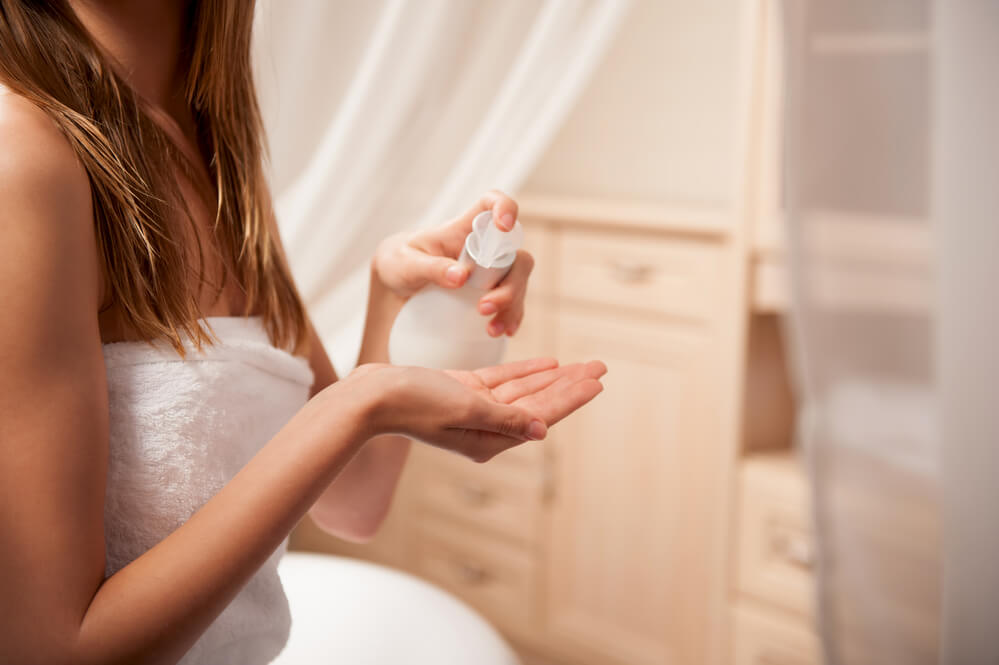
As you can see, soap is supposed to have a beneficial effect. Facial cleansers, especially, can help the more delicately balanced skin of your face stay healthy and youthful-looking.
However, there are several major flaws in most common soaps and facial cleansers — even the fancy, expensive ones.
Here is part one of what you need to beware of…
Moisture and Natural Oils Get Stripped Away
For many years, clean skin was synonymous with getting rid of “pore-clogging” oil as well as dirt and impurities. This meant that cleansers were formulated to strip skin of pretty much everything.
We now know that our skin naturally produces an oil called sebum for a good reason. It not only moisturizes skin and forms a protective barrier, it also plays a role in antimicrobial defense.
While overproduction of sebum can be a contributing factor to acne, maintaining a normal amount is essential for healthy skin.
Without a natural layer of oil, your skin will quickly become dry, red, and irritated. It will also show signs of aging more quickly because your skin barrier is impaired and unable to protect your skin from outside toxins as it should.
Most soaps and face washes still contain chemicals known as surfactants. Surfactants dissolve oil and dirt so that they can be washed away by water, since oil and water normally repel each other.
However, these surfactants can also strip away natural sebum and undermine your skin’s barrier, allowing impurities and bacteria to penetrate more deeply.
A better solution is a natural ingredient like aloe vera that cleanses pores without stripping your skin.
Above all, avoid cleansers with harsh surfactants that leave your skin feeling dry and tight.
High Alkalinity Disrupts Skin pH
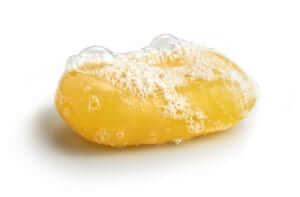
Another major downside of most conventional soaps is that they have a highly alkaline pH. This is because most are made by combining a fat or oil with an alkali like lye. This is what allows the soap to grab onto dirt and oil.
The problem is that your skin has what’s known as an acid mantle. This is an important protective layer made up of amino acids, fatty acids, and oils.
Because of this acid mantle, the normal pH of skin falls in a range of 5.4-5.9, which is on the acidic side. Staying within this range is critical for keeping beneficial bacteria on your skin thriving. Any damage to the acid mantle can open the way for pathogenic bacteria and cause skin dehydration and irritation.
Unfortunately, most common soaps on the market typically have a pH between 9-10. Some go as high as 11. This makes them not only alkaline, but very alkaline.
And while some have argued that alkaline soap doesn’t really affect skin pH, there is evidence that alkaline cleansers do in fact raise the pH level after washing with them.
There is often even more disruption from alkalinity because soap usually leaves a residue on your skin. This means it can keep affecting the acid mantle, even after you’ve rinsed it off.
Damage to the acid mantle accumulates over time, so you’re likely to notice the effects more as you get older.
Conventional bar soaps tend to be the most alkaline. Liquid cleansers and high-quality, handmade soap bars are usually closer to the pH of your skin.
Where Typical Soaps & Facial Cleansers Go WAY Wrong: Toxins
Your skin absorbs much of what is applied to it into your body — in many cases, all the way into your bloodstream. Studies have suggested that around 64% of what goes on skin gets taken into your body.
The thin skin areas of your body — such as your face, armpits, and private areas — absorb what is applied to them the most, as they are most permeable.
Furthermore, chemicals are more fully absorbed when your skin is moist and warm.
This is why it is so important you are aware of the artificial chemicals so many common soaps and facial cleansers can be loaded with!
You see, whatever your personal views on regulation, it is vital to know that the cosmetic and personal care product industries are highly unregulated.
They can add virtually any ingredient to their products, and the many artificial chemicals they do add are, in short, for their own gain, not yours.
Unfortunately, while around 1400 chemicals are banned from cosmetic and personal care products (such as soaps and cleansers) in the EU and other countries, only eleven — yes, just eleven — chemicals are currently banned in the U.S. by the FDA.
Therefore, it is definitely a case of “knowledge is power” and “buyer beware.”
Now, there are many chemicals you want to avoid in common soaps and cleansers, and it would take a book to list them all.
However, here are seven of the most common you want to watch for on soap and cleanser labels:
#1- Parabens
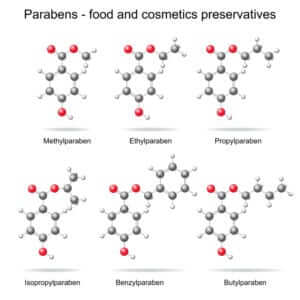
Parabens are a common preservative used to prevent bacterial growth in personal care products. They are easily absorbed into your skin and are associated with a host of negative effects.
Most notably, parabens can mimic hormones within the human body. This makes them endocrine disruptors that affect the hormonal health of both men and women. They are also connected to developmental problems and cancer.
Look out for different forms of parabens, including butylparaben, propylparaben, and methylparaben.
#2- Sulfates
Sulfates are used as surfactants in soaps and increase foaming and lather. The two most commonly used are Sodium Lauryl Sulfate (SLS) and Sodium Laureth Sulfate (SLES).
The key problem with sulfates is that they can strip your skin of healthy oils. Long-term use can lead to skin irritation and sensitivity. There are also concerns that they have a major negative impact on the environment. Aquatic wildlife seems to be especially affected.
#3- Fragrance
Seeing the word “fragrance” on the ingredient list for any product should immediately send up a warning signal. Companies are allowed to keep their fragrance cocktail a secret. This means there could be a large number (sometimes hundreds) of undisclosed chemicals hiding in a cleanser.
Fragrance additives are likely to cause allergic reactions, skin sensitivity, and irritation. Several common fragrance compounds, including phthalates, are potential carcinogens and hormone disruptors.
There’s every reason to avoid “fragrance” like the plague. If you really want a scented product, look for one that has natural plant extracts or essential oils.
#4- Formaldehyde-Releasing Preservatives
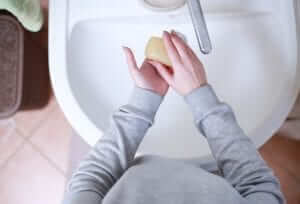
Formaldehyde is a chemical with dangerous side effects, even at low-level exposure. It is classified as a carcinogen by the International Agency for Research on Cancer. It’s also been found to cause respiratory problems, skin irritation, and dermatitis.
Most often, formaldehyde isn’t added directly to soaps or cleansers. However, several common preservatives are known to release formaldehyde. These chemicals are readily absorbed by the skin and are even found in baby soaps!
A few countries have banned these preservatives and many others have severe restrictions in place (not the U.S).
Some common ones are: diazolidinyl urea, imidazolidinyl urea, quaternium-15, dimethyl-dimethyl (DMDM) hydantoin, and 2-bromo-2-nitropropane-1,3-diol (bromopol).
#5- Cocamidopropyl Betaine
Cocamidopropyl betaine is a synthetic chemical and another surfactant. It increases foaming action and can be found in hand soap and other cleansers.
In 2004, this chemical was named ‘Allergen of the Year’ by the American Contact Dermatitis Society due to the frequency with which it was causing skin irritation. Sensitization becomes more likely the longer it’s used, and some people are very sensitive.
Look out for it under these names as well: Cocamidopropyl dimethyl glycine, Cocoamphocarboxypropionate, Cocoamphodiproprionate, CADG, and Disodium cocoamphodipropionate.
#6- 1,4-Dioxane
This particular chemical isn’t something you’ll see on any ingredient list. It’s actually a byproduct created when other chemicals — like sodium laureth sulfate — are combined during manufacturing.
The EPA lists 1,4-Dioxane as a likely carcinogen that’s frequently present in cosmetics. It can cause skin irritation, respiratory problems, and kidney and liver damage.
The best way to avoid it is to avoid other synthetic chemicals.
You may also want to look for USDA Certified Organic soaps and cleansers, since one large study found that USDA Certified Organic products were all clean of 1,4-Dioxane.
#7- Antibacterial Chemicals
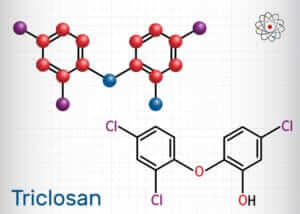
Triclosan is a nasty antibacterial chemical that has been linked to cancer, allergies, hormonal disruption, and more. Thankfully, it has now been banned from soap — but somehow it is still allowed in other personal care products such as common anti-aging creams!
In regards to soap and facial cleansers, the problem is that other antibacterial chemicals escaped this ban and can still be added . These include benzalkonium chloride, benzethonium chloride, and chloroxylenol (PCMX).
Not only have soaps with these chemicals not been proven more effective than “plain” soap and water, overuse of antibacterial soap has likely contributed to antibiotic resistance. They also appear to have their own negative side effects, much like triclosan.
It’s very important to try to avoid these antibacterial chemicals!
Beware of Misleading Labels & Marketing Tactics
After reading about these toxic chemicals in soaps and facial cleansers, it seems to make sense to opt for an “all-natural” or “organic” brand, right?
The answer is yes — and no.
Products with highly effective and truly natural ingredients are the best. However, just because something has a nice-sounding label doesn’t mean it contains what it claims.
It’s always important to remember that the skincare industry is very unregulated. There are few rules that guide what companies can and can’t claim on their labels.
For example, the FDA currently has no definition of the term “natural” as it applies to cosmetic products. This means it’s completely up to the interpretation of the manufacturer.
Furthermore, a product could contain just a single organic ingredient and yet have “organic” printed in large letters on the front for the marketing effect.
The best way to be certain you are getting truly clean and toxin-free soaps and facial cleansers is to look for “USDA Certified Organic” on the label.
This is a strict certification — independent of the company — that it is free of synthetic and toxic ingredients.
USDA Certified Organic also ensures that the natural ingredients used in the product were grown and processed organically, without pesticides, chemical fertilizers, dyes, industrial solvents, and other chemicals that do not belong in your body.
What All This Leads To + Where to Go From Here
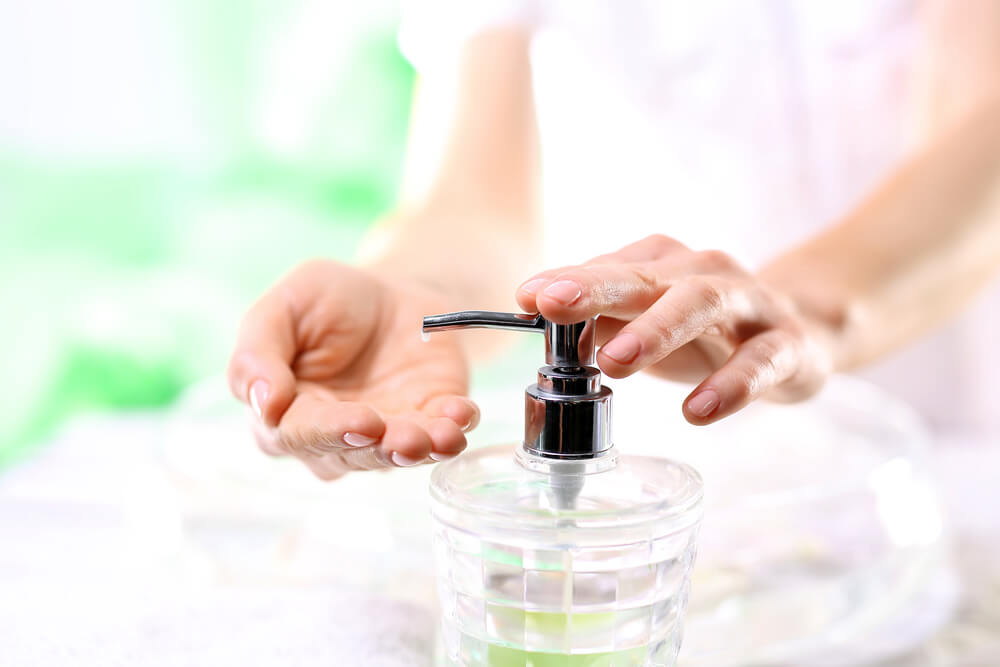
The end result of using common soaps and facial cleansers is that they can end up harming your skin — and your health.
The reason many cleansers appear to work is because they use synthetic chemical ingredients designed to give you quick results.
For example, many have surfactants that make your skin feel clean or exfoliators that brighten skin tone.
However, because these ingredients aren’t good for your skin, you’ll eventually notice effects such as dryness, dullness, and irritation.
As you have seen, these chemicals can also accelerate skin aging and, worst of all, contribute to health issues. Plus, the longer you use them, the more pronounced the effects can become.
Reading labels carefully is always a good first step.
At the least, watch for and try to avoid soaps and cleansers with “fragrance” and the other ingredients noted above.
(NOTE, though, that there are many other chemicals used in common soaps and cleansers you also want to avoid.)
Instead, look for soaps and facial cleansers that use only organic plant-based ingredients.
Again, though, please do not fall for “greenwashing” marketing tricks, such as a manufacturer calling its own products “organic” or “natural.”
Be sure to look for strict certifications on the product that confirm — independent of the company — that it truly is organic and free of artificial chemicals.
In the US, the most trusted of these is USDA Certified Organic.
Top Recommendation: Pur-Radiance, The Ultimate Organic Face Cleanser
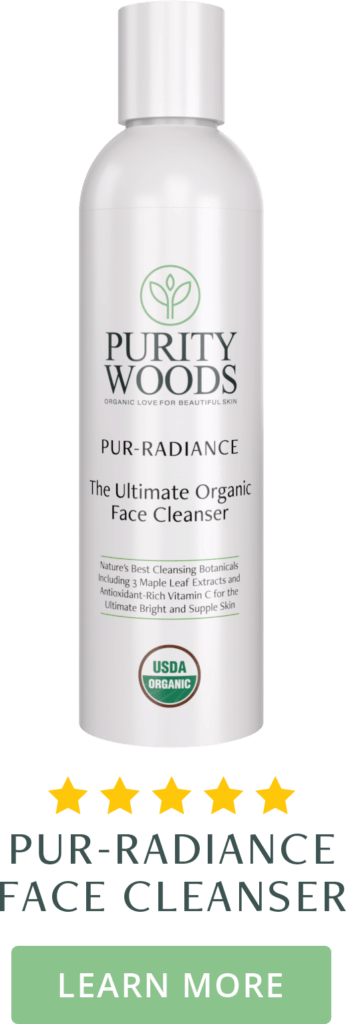
If you are “in the market” for a facial cleanser that uses only nature’s most potent plant ingredients to deeply yet gently cleanse your skin — and that is USDA Certified Organic — check out the Pur-Radiance, The Ultimate Organic Face Cleanser from Purity Woods.
It’s made of 21 plant ingredients that thoroughly cleanse your skin and keep it hydrated and healthy.
For example, Pur-Radiance includes organic pumpkin seed oil, which helps to deeply cleanse while also naturally moisturizing and promoting firmer-looking skin.
It includes an organic moss extract that helps purify your skin with its natural antibacterial and antifungal properties.
Pur-Radiance includes 3 different organic maple leaf extracts, which powerfully boost your skin’s elastin and eliminates the appearance of wrinkles and sagging.
As one more example, it also includes organic chamomile flower extract, which helps to cleanse while it also combats dry-, “papery”- and weathered-looking skin!
Click here to see all the organic plant ingredients in Pur-Radiance and to try it with today’s special offer (including FREE U.S. shipping)And, again, Pur-Radiance is USDA CERTIFIED ORGANIC.
This means it is strictly and independently verified to be free of any of the artificial chemicals so common in other soaps and facial cleansers out there!
Learn more about the USDA Certified Organic PUR-RADIANCE facial cleanser here, and give it a try if you are interested with today’s special offer.
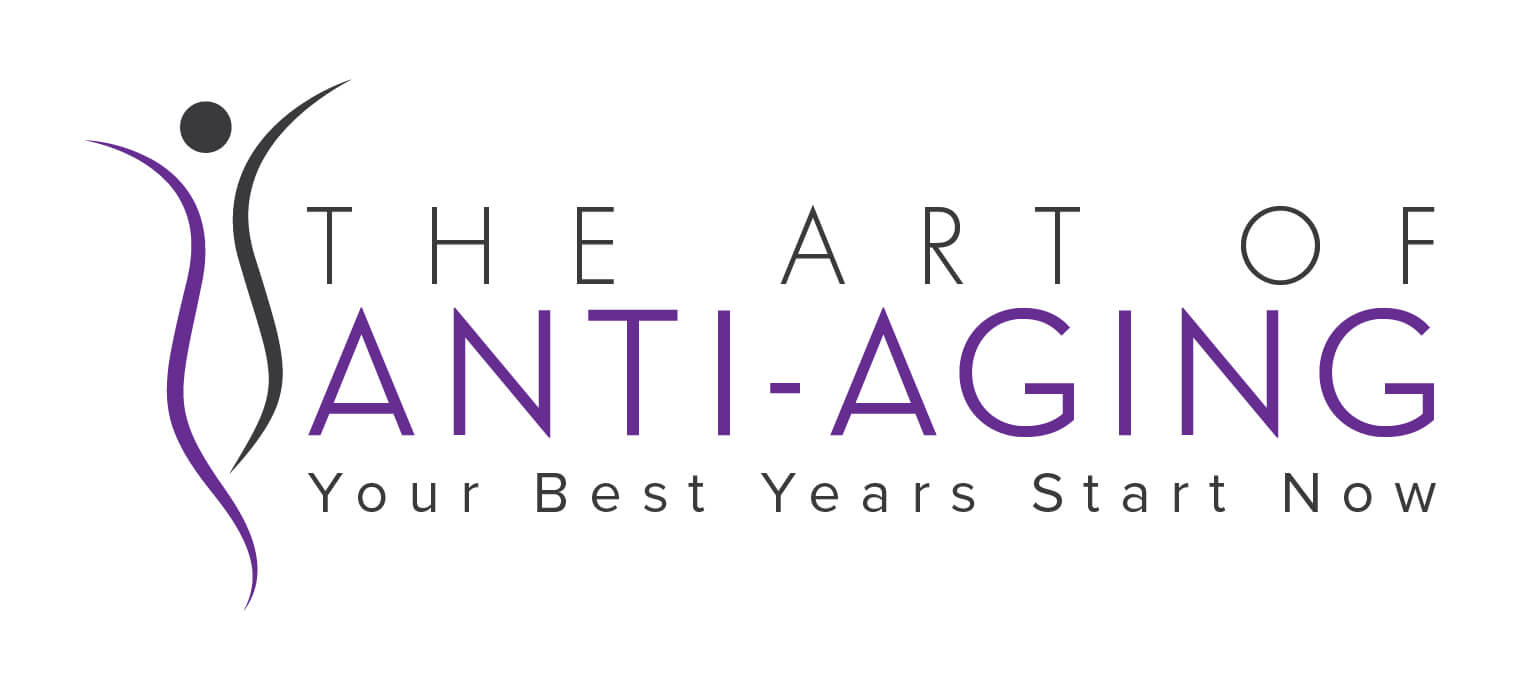
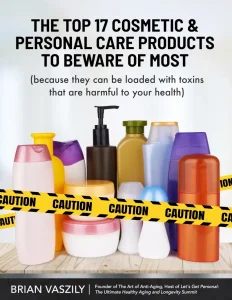
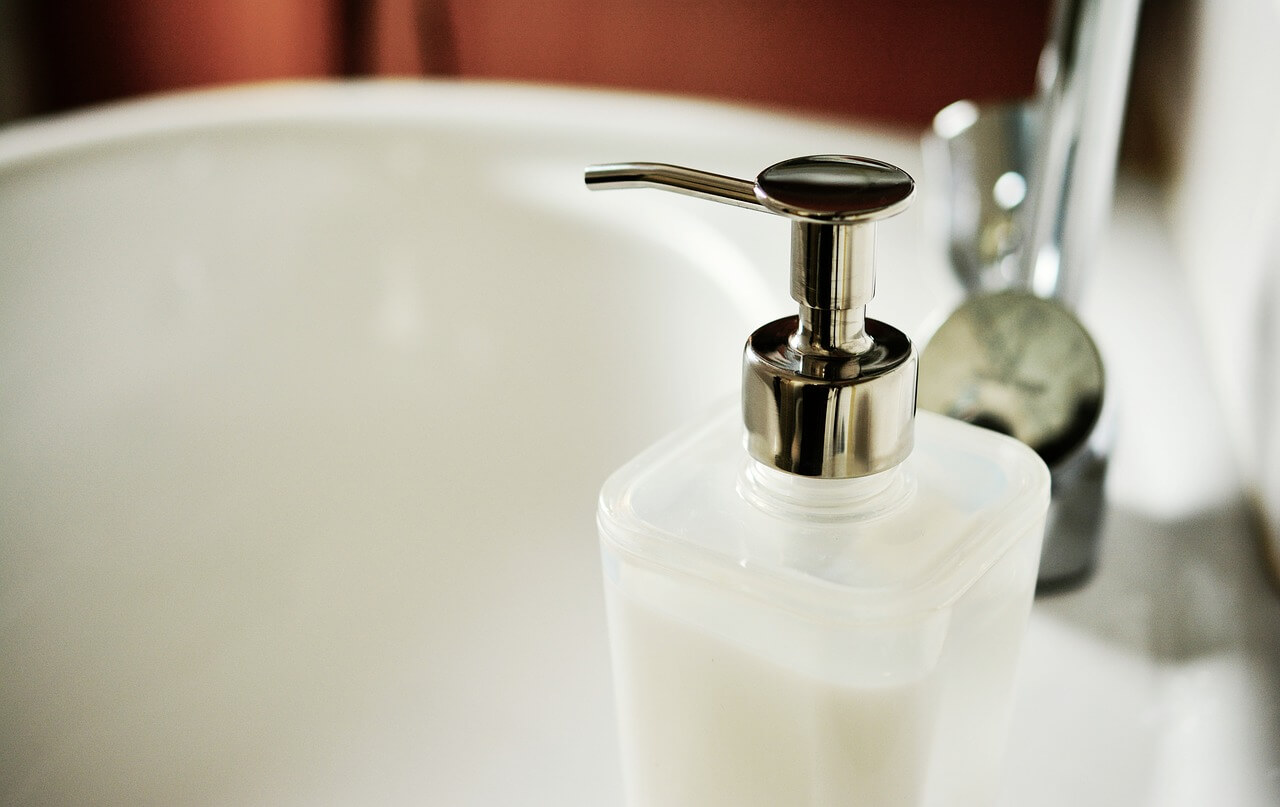
Excellent article! Very informative!
I have been using Purity Woods’
Elastin Boost Hyper-lift serum for a few days now and no complaints,
excellent article
Thanks Brian! Very informative (as always)!
I live in Canada, am I able to have your product shipped here?
Hello Mel, thank you. And, yes, Purity Woods ships to Canada (here’s Pur-Radiance link if interested: https://store.puritywoods.com/pur-radiance/)
What about cleansers for my whole body. Are they available?
Hi, search online for “USDA Certified Organic soap,” there are many soaps for body (bar soaps etc) that are truly organic these days! 🙂
This article is very informative. I never use soap on my face. I use a cleanser. Now if I can use the one mentioned this would make me very happy
. Where can I get this product?
Hi Veronica, thank you. You can get Pur-Radiance here (scroll to bottom of page for ordering info): https://store.puritywoods.com/pur-radiance/
Thank you very informative
Thank you or that enlightening information!
Appreciate your appreciation! 🙂
Great article and written so newbies can understand
I love the very specific list and have made it a note in my phone so when I’m out and about trying to replace a product or find something new or a sale, I can read the label and use the list as an automatic disqualified. The label lists aren’t easy to decipher. This article makes it easier. EWG is helpful too, but takes too long in the moment (in my experience).
Hi Crystal, thanks re note on specific list. Yes, the challenge with all the toxins that can be in these products is that they number at least in the hundreds… so it is mighty hard to check them all, refer to EWG, etc. That is why the most efficient way (for those in USA) is to look for the USDA Certified Organic logo. (Other countries have equivalent, like EcoCERT in France, for example.)
Thanks for useful information!
Excellent article about a very basic safety skin measures..words do fail to praise you..
I enjoyed reading through your information. Is it sold in New Zealand?
Sorry I mean your facial cleanser
Hi Pauline, yes, Purity Woods ships to most countries including the amazing country of New Zealand 🙂
Wow! Thank you for the really informative article!
Blessings to you and your family!
Thank you, Elizabeth!
You are specific enough to make your insights helpful and understandable on this vital topics, thanks so much, Kare Anderson
ABSOUTELYYYYYYYYYY to all of the responses above. Great Information!!!!!!!!!!!!!!!!!!
Let’s Continue to Stay Safe, Healthy, and above all, Prayed Up!!!!!!!!!!!!!!!!!!!!!!!!!!!!!!!!!!
Appreciate all your articles very much! And actually enjoy your Dad Jokes!
Very helpful! Thank you for the detailed information!
Very informative information, thank you.
Do your products list their pH value on the label?
Thank you,
Cindy
Very good article. I have used homemade soap for quite awhile now. I noticed that soap i bought irritated my skin. Am very conscious of what i put on and in my body.
Thank you for this vital information. I am well aware of many of the chemicals that are dangerous, however, as the consuming public becomes more educated, the manufacturers find ways to get around the information, they change the names of the chemicals they use, or they simply don’t include them in the listing, by calling them fragrance. I read all of the information you put out, for the updates you provide, and the jokes are always so good, I can not resist, even when I should not be on the computer I always break for your insights, and I research the products that pop up on the screen. Thank you so much.
Very good informations!
Thanks Brian! I really appreciate you distilling this abundance of information so succintly.
Two years ago I suddenly broke out with eczema in patches all over my body and head. I’ve never had eczema. I had to eliminate every soap my body came in contact with: body and facial soaps, shampoos and conditioners, laundry detergent and anything else that had fragrances and other chemicals like some mentioned here in it. What a journey! This article really nails most of chemicals I was reacting to – even as my allergist only identified fragrances. It is so worth the effort to examine what you’re putting on or near your skin. So good to know about this product. Thank you!!!
Very informative & always try to use hand made soap when available and try to NOT use liquid shower gels . Is this the right way round in preferance ? Also with the anti-bacterial soaps (because of Covid), are these worse or better than the everyday soaps ? Many thanks for the info. anyway and will look out for the organic ones.
here’s my 2 cents, please correct me if I’m wrong. Antibacterial soaps are hazardous to us on several levels. First, they are not necessary, not even for covid, especially since covid is not bacterial. They at best kill an extra .04% of bacteria, and those strains are rare, almost exclusively showing up in hospitals. But using these soaps, or anything antibacterial when it’s not necessary, does kill too many bacteria that would otherwise be harmless, thereby actually increasing resistant strains of bacteria, so we are adding to the increasing problem of bacterial resistance, and helping create super bugs (similar to feeding antibiotics to cows preventatively).
I have used Purity Woods cleanser and dream cream for a long time. I am very impressed with the results long term and will soon be restocking my supply.
Thanks for a great article and effective products.
This is really great information. Thank you very much.
Thank you Brian for all the research you do and then share with us. You have become a trusted and reliable source of information I always want to read and follow!
When I was a spiritual care volunteer in medical facilities, I had to desanitize my hands when going in and coming out each patient room. During the following nights, I felt like having been run over by a truck, including brain fog. Eventually, I discovered the cause, TRICLOSAN.
Thank you for this, and all your very helpful articles. They are all extremely helpful. Don’t stop the dad jokes. I may groan at some, but enjoy them. Smiling is good !
Since healing myself naturally of cancer 18 years ago, I have not used any form of facial cleanser whatsoever except water and sometimes a washcloth. At times I have tried an organic eye serum or a rose/witch-hazel toner, but for the most part my only face product is a light application of jojoba oil each day. My skin is always receiving compliments, and I am well into my forties. People ask, “What’s your secret?” I always say water and jojoba oil, that’s it! I don’t mean to say your product isn’t lovely – it is! I wish more truly organic products were available for people that desire them.
thank you! I have known about most of this for a long time, but you went much further into the issues than I ever got. Plus you lay it out logically so it’s easier to remember. I also appreciate your commenters!
Hi Michal, and thank you!
I’ve been using purity Woods cleanser for many years now. also the purity Woods night cream. I was using the day cream until I ran out. I’m using some other supposedly clean moisturizers until they are gone. also, I appreciate your dad jokes. LOL
Hi Marlyse, thank you on all fronts… regarding the dad jokes, can’t resist sharing, and even “roll your eyes” laughter is healthy! 🙂
Very interesting even for us in Europe I discovered that both my facial cleanser and shower gel contained cocamidopropyl betaine even though they were bought in a health food store
excellent explanation